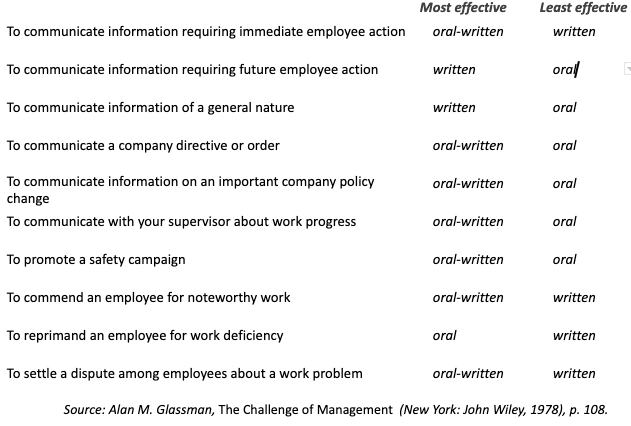¿Qué encontrarás en este artículo?
ToggleWilliam J. Reddin*
When to use oral and written communication
Characteristics of creative people
- Sensitivity: the ability to see problems.
- Evaluation: the ability to distinguish between ideas that will and ideas that won’t solve problems.
- Fluency: the ability to generate a large number of ideas rapidly.
- Flexibility: the ability to change frames of reference.
- Elaboration: the ability to embellish an idea with details.
- Transformation: the ability to combine things in new ways.
- Originality: the ability to come up with unusual (that is, statistically infrequent) ideas.
- Preference for complexity.
- Independence of judgment: willingness to hold a position in the face of disagreement.
- Separation of information from source: the tendency to evaluate information by itself rather than on the basis of its source.
- Relativism: the tendency to look at things in relative, rather than absolute, terms.
- Good sense of humor.
- Rich fantasy life.
- Deviance: the characteristic of seen oneself as different from others.
Source: Thomas R. Gildersleeve, Successful Data Processing Analysis (Englewood Cliffs, NJ: Prentice-Hall, 1978), p. 202.
How to analyze communications problems
Do you have a communications problem?
- Do all managers and employees know what they are expected to achieve?
- Do work problems and departures from plan get picked up early enough for effective action?
- Are new developments in the outside environment −changes in customer demand, activities of competitors, advances in technology, and political or economic developments− picked up quickly and accurately Does this information get to those best able to use it?
- Are any of your customer-service problems −quotations, deliveries, meeting special requirements, giving accurate information − due to poor communications between departments?
- Does work get duplicated between departments?
- Do managers complain that they spend too much time at meetings or dealing with paper?
-
Do many employees feel indifferent or hostile to the organization because they are not kept informed about it?
Is it an organization problem?
- How does your organization ensure that each manager, and employee, gets the information needed for the job?
- Does essential information travel directly from one department to another, or does it have to go up the reporting ladder and down again?
- Does information get “censored” or filtered out between management levels and between departments?
- Do product groups or profit centers pass on information that could be used by, or jointly with, other groups? Or do they keep back information from internal “competitors”?
- Do corresponding specialist groups in different divisions share information and know-how?
- Do managers and specialists in different departments or functions understand each other’s problems? Do they exchange information on new developments in their special areas? Do they talk to each other?
- Do any of your managers spend so much time communicating that they have difficulty in doing their basic job?
Is it a systems problem?
- Does each employee have continuous information on the work objectives and results, in both quantity and quality?
- Does each manager receive adequate information, with sufficient frequency, on the results produced by subordinates?
- Do managers regularly and systematically exchange information about objectives and results with their subordinates?
- Are aspects of organizational performance, such as machine efficiency, material utilization, operator performance, quality, delivery, and customer complaints, monitored in such a way that changes in performance level can be detected?
- Are sales and market forecasts monitored against actual results?
- Do the control systems (stock control, credit control, production control, quality control, cost control) contain automatic provisions for informing or consulting all interested parties on critical decisions and changes?
- How are relevant developments in the organization’s environment monitored?
Is it a manager-subordinate relations problem?
- Do managers talk to their subordinates other than to give instructions?
- Do employees talk to their manager, other than to answer questions?
- Do managers and subordinates listen to each other?
- Do managers pass on as much or as little information as possible?
- How much feedback, both positive and negative, do employees get from their manager about their job performance?
- Do managers understand how nonverbal communications (tone of voice, expression, receptiveness, eye contact, etc.) can either reinforce or cancel out their verbal message?
- Do managers communicate with their subordinates as a group as well as singly? Do they encourage communications within the group?
- What training could assist managers to improve their relations with subordinates?
Is it a media problem?
- How do employees get to know about the organization’s plans and achievements and about change that might affect or interest them?
- What links do employees have with the organization as a whole, apart from their immediate working group?
- Does the organization have a newspaper? What do employees think of it?
- Does the newspaper aim to inform about:
- plans for the future?
- present performance, successes, problems?
- the organization’s environment?
- the work of different departments?
- news about individuals?
How well does it succeed in each of these?
- What media are used in:
- the induction of new employees?
- passing on information from top management?
- explaining changes in conditions of employment?
- Is sufficient use made of film, videotape, tape, slides, text, pictures?
Is it a political problem?
- Which managers, departments, or groups of employees are powerful because they control information? Would better communications weaken their power?
- Is lack of trust between management and employees (or their unions) due to poor communications or to past experience?
- How and when are employees told about changes in the system, methods, or organization? What opportunity do they have to influence the changes?
- Are employees resisting change because they do not understand it, or because they think it is against their interests? Might they be right?
- Do employees want to be informed about management intentions, or to be consulted, or to share in decision making?
Source: “Effective Communication”, BIM Checklist, 76.
Giving a talk
Preliminary considerations
- What is the purpose of your talk?
- Who will make up your audience? How large will it be?
- How long will your talk last? Can you cover the ground adequately in that time?
- Are you intending to give an introductory talk or a lecture? How much does your audience know already?
- How will you approach the subject? Do you want to inform or to persuade?
- Will there be a discussion or questions at the end?
- Have you enough time to prepare your talk?
- Will you use visual aids, handouts, and so on? Is there time to prepare the material? Are all the facilities for visual aids available?
- Where will you give the talk? Who is responsible for the practical arrangements?
If you cannot answer these preliminary questions to your satisfaction, think again before proceeding.
Collecting ideas
- How will you collect ideas on the subject and its treatment?
- Have you tried using index cards to jot down ideas as soon as they arise?
- What facilities do you have for research and collecting information? Who will be able to help you?
- Have you considered relating your subject to people, events, and projects?
Arranging your material
- Have you prepared your arguments and key points in a clear and logical sequence?
- How will you get the main points across?
- Have you considered how much your listeners can absorb in the time available? Will you hand out a duplicated summary at the end?
- How will you deal with audience reaction?
- Have you considered keeping the audience small by giving the same talk twice?
- Will you
- read your speech?
- speak from brief notes (headings and subheadings only)?
- speak from detailed notes?
- memorize the whole speech?
- How will you start your talk?
- with a statement of its objectives
- with a relevant story, anecdote, or quotation?
- by discussing the key word of the subject
- by asking a series of questions
- by quoting some striking facts
- with some reference to local events or places
- with some reference to your audience’s common interest
- How will you conclude your talk? Will you:
- summarize your main points?
- ask a provocative question?
- make an appeal for action?
- Have you considered “planting” a few questions to bring out points not covered in the talk?
Preparation for delivery
- If you must read your talk, is it typed in double spacing on one side of the paper with clear subheadings? If it is in note form, are the notes written clearly on one side of index cards?
- Have you numbered the pages or cards?
- Have you timed your talk and indicated the timing on each section of your notes?
- Have you rehearsed your talk out loud? Have you cut out the words that often trip you up?
- If there are to be other speakers, have you discussed the program with them?
The performance
Have you considered the following dos and don’ts?
- Stand or sit up straight –but not rigid.
- Don’t gesticulate wildly.
- Speak distinctly; address the back of the room.
- Vary your speed and pitch; be careful not to get faster.
- Look at your audience.
- Pause after making important points.
- If you read your speech, look up as much as possible.
- If you are standing, do not look down at your notes but lift them forward and up when you refer to them.
- Watch the time!
- Avoid jargon, slang, and superfluous words.
- Avoid jokes unless they are really funny and relevant.
- If you are using a blackboard, do not speak with your back to the audience; use a pointer.
- If the unexpected happens, react naturally.
- Speak with conviction and enthusiasm.
- Be natural and sincere. Try to smile.
Source: “Giving a Talk”, BIM Checklist, 50.
*Taken from the book: “The Smart Manager’s Book of Lists”. W.J. Reddin,
Lake Publishing Company, pp. 167-175.










